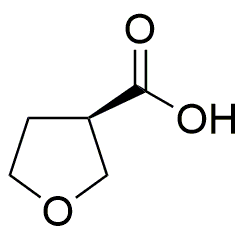(R)-Tetrahydro-3-furoic acid is widely utilized in research focused on
- Pharmaceutical Development: This compound serves as a key intermediate in the synthesis of various pharmaceuticals, particularly in the development of drugs targeting neurological disorders.
- Biochemical Research: It is used in studies exploring metabolic pathways and enzyme activity, providing insights into biochemical processes critical for understanding diseases.
- Polymer Chemistry: The compound can be incorporated into polymer formulations, enhancing properties such as flexibility and thermal stability, making it valuable in materials science.
- Agricultural Chemicals: It finds applications in the formulation of agrochemicals, contributing to the development of more effective herbicides and pesticides.
- Flavor and Fragrance Industry: Its unique structure allows it to be used as a flavoring agent, offering a natural alternative in food and cosmetic products.
General Information
Properties
Safety and Regulations
Applications
(R)-Tetrahydro-3-furoic acid is widely utilized in research focused on
- Pharmaceutical Development: This compound serves as a key intermediate in the synthesis of various pharmaceuticals, particularly in the development of drugs targeting neurological disorders.
- Biochemical Research: It is used in studies exploring metabolic pathways and enzyme activity, providing insights into biochemical processes critical for understanding diseases.
- Polymer Chemistry: The compound can be incorporated into polymer formulations, enhancing properties such as flexibility and thermal stability, making it valuable in materials science.
- Agricultural Chemicals: It finds applications in the formulation of agrochemicals, contributing to the development of more effective herbicides and pesticides.
- Flavor and Fragrance Industry: Its unique structure allows it to be used as a flavoring agent, offering a natural alternative in food and cosmetic products.
Documents
Safety Data Sheets (SDS)
The SDS provides comprehensive safety information on handling, storage, and disposal of the product.
Product Specification (PS)
The PS provides a comprehensive breakdown of the product’s properties, including chemical composition, physical state, purity, and storage requirements. It also details acceptable quality ranges and the product's intended applications.
Certificates of Analysis (COA)
Search for Certificates of Analysis (COA) by entering the products Lot Number. Lot and Batch Numbers can be found on a product’s label following the words ‘Lot’ or ‘Batch’.
*Catalog Number
*Lot Number
Certificates Of Origin (COO)
This COO confirms the country where the product was manufactured, and also details the materials and components used in it and whether it is derived from natural, synthetic, or other specific sources. This certificate may be required for customs, trade, and regulatory compliance.
*Catalog Number
*Lot Number
Safety Data Sheets (SDS)
The SDS provides comprehensive safety information on handling, storage, and disposal of the product.
DownloadProduct Specification (PS)
The PS provides a comprehensive breakdown of the product’s properties, including chemical composition, physical state, purity, and storage requirements. It also details acceptable quality ranges and the product's intended applications.
DownloadCertificates of Analysis (COA)
Search for Certificates of Analysis (COA) by entering the products Lot Number. Lot and Batch Numbers can be found on a product’s label following the words ‘Lot’ or ‘Batch’.
*Catalog Number
*Lot Number
Certificates Of Origin (COO)
This COO confirms the country where the product was manufactured, and also details the materials and components used in it and whether it is derived from natural, synthetic, or other specific sources. This certificate may be required for customs, trade, and regulatory compliance.


